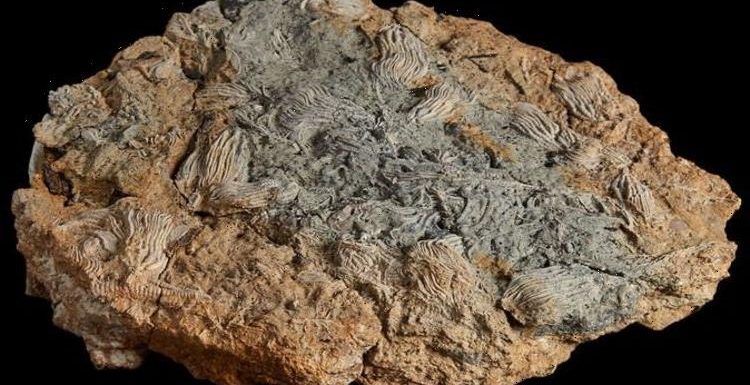
Jurassic Coast: Incredible Ichthyosaur jaw discovered on the beach
We use your sign-up to provide content in ways you’ve consented to and to improve our understanding of you. This may include adverts from us and 3rd parties based on our understanding. You can unsubscribe at any time. More info
From prehistoric starfish to fossilised sea cucumbers, the discovery has been hailed as one of the biggest and most important troves of Jurassic-era (199.6 million to 145.5 million years ago) echinoderms. Echinoderms are a family of seafloor animals that include starfish, brittle stars, sea lilies, sea urchins and sea dollars among others. The fossils were uncovered at a secret site in the Cotswolds by non-professional palaeontologists Sally and Neville Hollingworth.
The fossil-hunters alerted the Natural History Museum of their find, believing they have stumbled upon something incredible – and the Museum’s experts agreed.
Mr Hollingworth told the BBC: “What we’ve got here is a sort of Jurassic Pompeii.”
And Dr Tim Ewin, Senior Curator at the Natural History Musuem, praised the “exceptional preservation” of the site’s Jurassic critters.
The uncovered fossils represent virtually every member of the echinoderm family – a rare feat on its own – and hold their own against some of the world’s best-known palaeontological sites.


The Cotswolds cover an area of nearly 800 square miles in the Gloucestershire, Oxfordshire, Warwickshire, Wiltshire and Worcestershire counties.
But more than 167 million years ago the picturesque region would have been a warm and fairly shallow sea.
The conditions would have been perfect for a diverse multitude of echinoderms to cover the seafloor.
Dr Ewin added: “It seems likely that a river was flowing into the sea nearby bringing in high levels of nutrients which attracted the large numbers of echinoderms we are finding.
“It then appears that the whole area was rapidly buried during an underwater mudslide.


“This is evidenced by the fact that we are finding some fossilised stalked and unstalked crinoids here in what we refer to as a ‘death pose’, where the animals have died trying to shield themselves by wrapping their arms around their bodies.”
Although cataclysmic for the echinoderms, the mudslide helped preserve the creatures to an exceptional degree.
Some of the discovered fossils, such as sea lilies and starfish, are rarely found in the fossil record.
Their brittle skeletons quickly fall apart after death, unless they are buried in the seabed.
The Hollingworths explored the secret site during lockdown, returning later with permission from the landowners.


Ms Hollingworth said: “We were looking for new sites to explore once lockdown ended.
“We do this by scrolling through Google Maps around areas we know fossils have been found.
“The site we eventually discovered, a small quarry, seemed perfect.”
According to Mr Hollingworth, the pair was not expecting to find more than a few fossilised specimens.
Instead, he said they stumbled upon a graveyard of great scientific importance.
So far, three days of excavations have yielded more than 100 slabs that are being prepped for further study.
Among them are the fossils of creatures that scientists still know very little about.
Mark Graham, Senior Fossil Preparator at the Museum, said: “Many of the specimens we have excavated are trapped in large slabs of clay in groups.
“We now need to carefully explore these blocks to discover the most scientifically important specimens and prepare them for public display.
“We have collected enough material to keep us busy for quite some time but I am hopeful that once cleaned up these fossils will provide a huge amount of new information about how these creatures and their long-gone ecosystem functioned.”
The palaeontologists are now hoping to return to the site in the hopes of identifying new species of feather star, brittle star and sea cucumbers.
The discovery will help scientists better understand how these critters evolved and diversified into the creatures we see today.
Source: Read Full Article